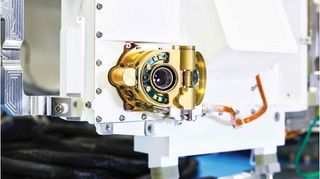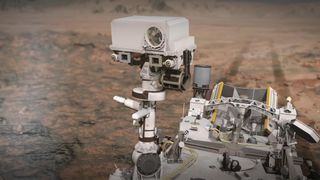The quest to find life beyond our planet has captivated humanity for decades, driving missions that continue to push deeper into the solar system. Last summer, NASA’s Perseverance rover made a groundbreaking discovery on Mars when it detected carbon-based molecules, known as organics, that many scientists believe could hint at the possible presence of ancient extraterrestrial life.
The finding has fueled excitement and debate within the scientific community, as it brings us closer to answering the age-old question of whether life ever existed — or maybe still does — on the Red Planet.
However, there may be a bit of a caveat: Scientists can't be sure that the signals are 100% attributable to organic molecules. Though, for many, the possibility is likely, it’s not the only explanation, and the uncertainty comes down to the rover's instruments — they can provide strong indications and gather valuable data, but they are not as comprehensive as Earth-based laboratories.
For some background, Perseverance made the find using an advanced instrument called SHERLOC (Scanning Habitable Environments with Raman and Luminescence for Organics and Chemicals), which is designed to hunt for organic molecules.
Related: NASA's Perseverance rover begins ambitious ascent up a Mars crater rim
"The SHERLOC instrument is our premier tool for detecting organic matter," Ken Farley, project scientist for the Perseverance rover mission, told Space.com. "It's really the only instrument that we think has a reasonable chance of finding organic matter at the concentrations that are likely present."
SHERLOC relies on two primary techniques: deep ultraviolet luminescence and Raman spectrometry. "SHERLOC's luminescence mode produces a very high signal per unit amount of certain organic molecules, but it is not especially diagnostic," said Farley.
Luminescence is the process by which a substance emits light as a result of absorbing energy — without exhibiting an increase in temperature. There are many examples of this, ranging from neon lights to fire flies. But onboard the Mars rover, SHERLOC takes advantage of this phenomenon to help identify the presence of different organic compounds.
But there is a catch: "Many, many things luminesce — there are other things that do that besides organic matter," said Farley. "It's related to subtle characteristics of the chemical composition of the materials."
This is where SHERLOC's Raman mode comes in. "It’s much less sensitive, but a much better fingerprint," Farley said. Raman spectroscopy is a technique common to most chemistry labs, where the vibrational modes of molecular bonds can be measured in order to glean information about a molecule's chemical structure.
"There are patterns of peaks in a Raman spectrum, and you can relate them to specific types of organic molecules," explained Farley. "But it's a trade off."
With both instruments, Farley believes there's a chance of detecting false positives. "You might draw the positive conclusion without recognizing that there are alternative interpretations," he explained.
Could Percy have found something else?
Perseverance was tasked with collecting and analyzing samples from Mars' Jezero Crater, chosen for its history as an ancient open-system lake approximately 3.5 billion years ago. On Earth, similar environments often show signs of ancient microbial life, making Jezero a prime target for investigating potential past life.
Using its SHERLOC instrument, the rover detected luminescence signals that initially suggested the presence of organic molecules. A paper published in the journal Nature reported these findings, indicating diverse aromatic molecules on the Martian surface that persist despite harsh conditions.
A year later, a study in Science Advances offered an alternative explanation, suggesting that the signals thought to indicate organics could instead come from inorganic materials, specifically cesium ions (Ce3+) in phosphate and silicate defects from ancient magma flows.
"Multiple chemicals can give rise to these same spectral features," explained Eva Scheller, a planetary scientist at the Massachusetts Institute of Technology (MIT) and corresponding author of the recent study as well as a contributing author on the original Nature paper. "In spectroscopy, we call this a degeneracy, [and it's] a very common challenge when trying to interpret spectra."
Degeneracy often makes interpreting these results impossible, according to Scheller, and in less critical cases, many scientists would typically leave the data uninterpreted. However, the stakes for the Perseverance team means there will be an ongoing push to try and interpret the data despite the challenges.
"Previous studies noted that the spectra are consistent in appearance with the luminescence profile of 1- and 2-ring aromatics, this is true," said Scheller, referring to specific organic molecules made of one or two connected carbon rings. Aromatic molecules are unique because their structures include stable, ring-shaped formations with alternating single and double bonds, known as conjugated bonds. These molecules are significant because they can be found in biological compounds, such as amino acids and pigments. However, while the detection of such molecules is intriguing, it doesn't guarantee biological origin. "And it does not mean much if the data is degenerate," added Scheller.
Farley and Scheller both point out that the original paper does note this as a possibility, and does also mention the possibility of Ce3+ and defect inorganics as alternative explanations. "They were presented among a menu of possible interpretations," said Farley.
Though it was determined that the presence of aromatic organics would be more likely, Scheller argues that this could come down to scientists' biases and fields of expertise.

Dealing with uncertainty
On Earth, ambiguous results like these can often be clarified by using different analyses to corroborate the findings. However, conducting experiments on Mars is much more challenging.
There is limited capacity to send bulky instruments on a rover that needs to travel between planets. As a result, equipment must be miniaturized and made mobile, all while operating in an extreme and unpredictable environment. Unlike Earth, where conditions can be controlled and instruments are highly sensitive and accessible, Mars presents harsh temperatures, dust storms, radiation and limited resources. These factors complicate precise analysis and introduce uncertainties, making it difficult to draw definitive conclusions from the data.
"This is the point of the whole sample return proposal," said Scheller. This would also allow the scientists to better understand the origins of any organic molecules, should it be determined they are present in the Jezero Crater.
But both Farley and Scheller are quick to point out that even if organic molecules are present, this doesn't mean they are a potential sign of life. "I don’t think anyone on the team — even the ones strongly proposing an organic origin for the luminescence signals — would argue that luminescing 1- or 2-ring aromatic organics could be a potential sign of life," said Scheller.
"To be able to differentiate abiotic types of organic chemistries [those created through non-biological processes] from life you need really sophisticated laboratory techniques utilizing highly detailed characterization methods—and you cannot do this with a miniature spacecraft instrument adapted to extreme environments,” she added. "In [our papers], we are simply showing that we're struggling to confirm or rule out the presence of basic abiotic organic molecules using SHERLOC."
Farley emphasizes that, while the back-and-forth may seem like disagreements among scientists, it is actually a vital and inherent part of the scientific process.
"This is error correction, and it's the way the scientific process has to work," he said. "[As a scientist], one needs to be open to that possibility that they may be wrong and not fight it.
"If you accept that if you put your arguments out there and somebody finds a better interpretation and you look at it and you agree, then science corrects itself — that’s just the nature of the beast, that knowledge evolves and that’s a good thing.”
.png)
 German (DE)
German (DE)  English (US)
English (US)  Spanish (ES)
Spanish (ES)  French (FR)
French (FR)  Hindi (IN)
Hindi (IN)  Italian (IT)
Italian (IT)  Russian (RU)
Russian (RU) 









Comments